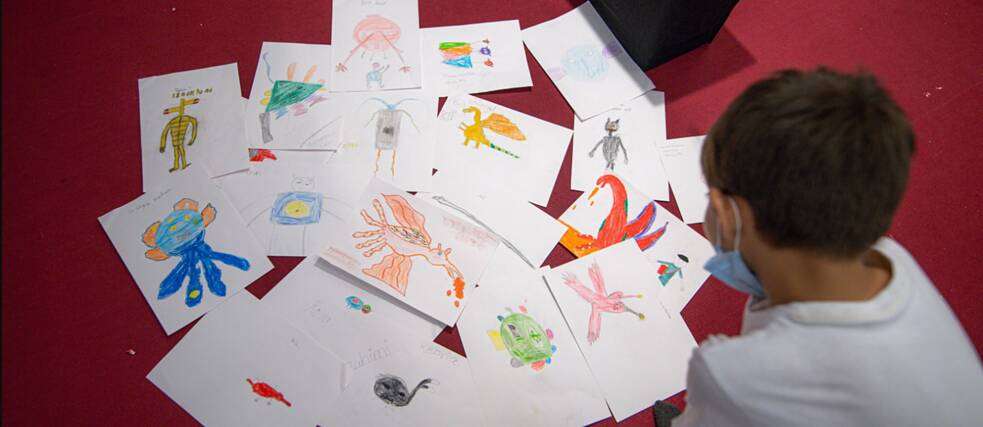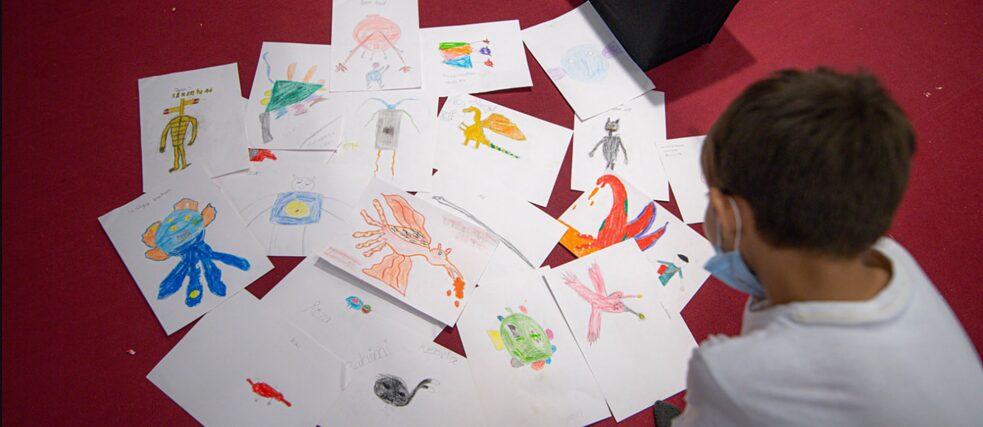“The Incredible Child”

Catching the Art by Eyes
At the end of the workshop, we collected the children’s art works. This child is looking for his own art in the mix.
|
© Goethe-Institut / Max Mueller Bhavan
The Simurgh Children’s Art Workshop is a monthly programme for children aged from nine to fifteen. These include children who live in and around Khirkee, a locality in south Delhi. Many, but not all, are members of the Afghan community who live in the area.
Each month, this group of children watched a film that led to a discussion on the themes of the movie, followed by art activities. The films chosen were in a variety of styles and from different countries and mostly relied on little or no dialogue.
These workshops were led by filmmaker Samina Mishra, who built each session around the belief that every child deserves a chance to dwell in the imagination. This is all the more important when working with communities like refugees and asylum seekers, who have limited access to spaces for play and leisure.
Working with children is key, says Samina, because they rarely figure in public discussions. In these sessions, children made friends and learned to talk about the things that mattered to them. They chatted about each others’ lives and found new ways to express themselves. They found the many things they shared on the streets of Khirkee, and celebrated the things that make each of us different.
I wish
This collection of artworks and poems written by the group emerged from the viewing of ‘I Like Life a Lot’, an animated film made by Kati Macskassy in 1977, that uses artwork made by a group of Roma children in Hungary. Equality and Power by Shahnama
Equality and Power by Shahnama“I wish I was a lawyer, to make the world a holy place for the people and for equality. And let the people speak up!” | © Goethe-Institut / Max Mueller Bhavan View artworks
Belonging-ness
Watching the 2010 Australian animation film The Lost Thing by Shaun Tan and Andrew Ruhemann led to a discussion on the idea of not fitting in. The children drew a variety of lost things from their imaginations; creatures with multiple heads and eyes, hybrids with robotic and animal traits, and things that seemed familiar and yet completely unrecognisable. Catching the Art by Eyes
Catching the Art by EyesAt the end of the workshop, we collected the children’s art works. This child is looking for his own art in the mix. | © Goethe-Institut / Max Mueller Bhavan View artworks
Who tells our stories?
‘Hum Chitra Banate Hain’, a film by Indian director Nina Sabnani, introduced the children to the gorgeous artwork of Sher Singh Bhil, who works with the traditional style of Bhil painting. The film also encouraged a conversation about who is the sutradhar, or the storyteller of their lives. Sound of Peace by Sarah Kakar
Sound of Peace by Sarah Kakar“I like birds because whenever I hear their voices it gives me peace. I listen to them whenever I go to a park. There are lots of parks near my house - Satpula, Jamun and Shivalik. I can recognise the crows and the sparrows. And there are some fallen trees in front of my house and I hear the birds on them too.” | © Goethe-Institut / Max Mueller Bhavan View artworks
Colour on our streets
Watching the classic 1956 film The Red Balloon by French filmmaker Albert Lamorisse made the group reflect on friendship, loneliness and their everyday spaces. Kiterunner by Lovekush
Kiterunner by Lovekush“I drew a kite because I love to be a kite runner and fly the kite from the roof.” | © Goethe-Institut / Max Mueller Bhavan View artworks
Football, friendship & forgiveness
This collection of art and writing emerged from watching ‘Rammat Gammat’, a short film by Ajitpal Singh. The movie is a delicate musing on friendship centred around the experience of inequality and a pair of football shoes. Special Feelings by Labina
Special Feelings by Labina“The feeling that I have in wearing my traditional clothes is as special for me as flying in the sky and seeing the rainbow.” | © Goethe-Institut / Max Mueller Bhavan View artworks
Borders
‘The Present’, by a film by Farah Nabulsi, is about a father and daughter from a Palestinian enclave in the West Bank, trying to cross borders to bring home a new fridge as a wedding anniversary gift. Pandemic by Khal Mohammad
Pandemic by Khal Mohammad“During the pandemic everywhere was shut and they were not allowing us to enter the park. That was the border I faced so I can say that it was the pandemic border.” | © Goethe-Institut / Max Mueller Bhavan View artworks



